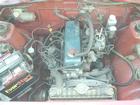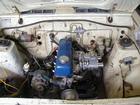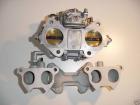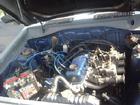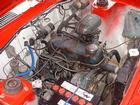Which Carburetor should I use?
Also see:
For in-depth info on carb tuning and performance, buy or borrow a book the type of carb you have. Try your local library or [1].
Contents |
Carburetor Types
Carburetors commonly used on Datsun 1200s include Sidedraft and Downdraft types.
Which is better? Sidedraft or downdraft?
With most inline engines sidedrafts are better because the air/fuel mixture goes more straightly into the cylinder. The air-fuel mixture doesn't have to go down the carb, then make a 90 degree turn in the manifold to get into the cylinder. This helps the airflow, but more importantly fuel doesn't turn as fast as the air, which can cause mixture distribution problems when the path isn't straight. But on a V8s or flat engines with the engine at an angle, the downdraught might have the advantage of a straighter path (this is why all-out V8s and Porsche engines often use Weber downdrafts).
Additionally, with twin dual-throttle sidedrafts on an inline four cylinder, you get the extra advantage of a tuned-port intake path for each intake port. This is just like the individual tuned-port runners used in fuel injection, which is good for low-speed torque, and good for high-end power. Though few if any sidedraft manifolds use long runners, but are instead designed for higher rpm (short runners), the individual throttles give good low speed torque.
discussion: Downdraught? Sidedraught
Downdrafts
Downdraughts carburetors include:
- Hitachi DCG306 (manual choke) or DCH306 (electric choke). This is the stock carburetor for Datsun A-series engines, and was also used by Honda and other auto makers
- Weber DGV/DGAV/DGEV 32/36 (progressive secondary throttle)
- Weber 38/38 DGAS (synchronous throttle, i.e. both throats open at the same time)
Stock Hitachi 306
The stock Datsun 1200 carburetor has the:
- best fuel economy
- best driveability and smoothness of throttle response, although properly jetted and synchronized Webers may run just as well (but take some tuning effort)
See the main article Carburetor Overview.
Weber DGV 32/36
The Weber DGV series downdraft carb is an excellent choice for the daily driver stock or lightly modified A-series engine. See the main article Weber 32/36 Carburetor.
Note that the Holley G180 and Holley 5200 are the same carburetor, as commonly found on Ford engines and others. These are made by Holley with a license from Weber of Italy.- Least expensive upgrade choice
- can use stock A-series engine manifold by using a simple adapter plate
- Uses the Solex two-barrel bolt pattern
Sidedrafts
Sidedraught carburetors are more performance-oriented as they feed the engine ports is a straighter line. But they are generally more expensive and require a special intake manifold. By contrast, a traditional downdraft caburetor will fit your existing manifold.
There are two basic kinds of sidedraughts:
- Variable-venturi. Here are the most common VV carbs. These are single-bore carbs (one barrel):
-
<li>Hitachi (SU-style) these are the stock Datsun GX carburetors)</li>
<li>SU carbs - made in England (not used by Datsun)</li>
- Conventional Sidedraft Carburetors. These are all dual-bore carbs (2-barrel). The following use the same intake manifold (same bolt pattern):
- Weber DCO/DCOE
- Mikuni-Solex PHH
- Solex ADDHE
- SK racing sidedraft
- Dellorto DHLA
HJE38W Hitachi Twin Sidedrafts (Datsun GX engine Hitachis)
These variable-venturi carbs are the factory setup for Datsun 1200 GX cars (twin SU-type Hitachis). Not sure if these are swappable with the SUs and Solex/Zenith-Stromberg carbs, but are of similar design. These were also fitted to the Bluebird 411 SS and SSS, 240Z/260Z, B110GX, B210GX, PE10, 180B SSS, P510 SSS, and 311 roadsters.
Available in "dome-top" through 1972 and then "flat-top" versions in 1973 and up. Most use the 38 (38mm bore), but there are 46s on the 2000cc Roadster.- <li>Angled runner design is generally a plus, although the a-series heads don't have angled runners to match</li><li>continuously variable venturi design (slides)</li><li>single throttle is a minus, compared to the dual Weber DCOEs (four throttles total)</li>





The Hitachis are tuned in a manner similar to SU carburetors. Here are links to tuning information:
- Original JAW
- Salman
- Sisson
- The Hitachi SU page, including the Haystick needle program for Datsuns
- Datsun Service Manual SU
Mikuni PHH
Mikuni bought the Solex PHH license in the early 1970s and thoroughly redesigned it since then. The only parts in common between these two carbs are the diaphragm accelerator pump arrangement. The Mikuni now resembles a cross between a Weber DCOE and a Solex. They are the "set and forget" sidedrafts. Their flow rates aren't quite as high as the Webers, which is why they're not favored by racers, and jet availability is not as good. (Mikuni North America is the primary jet supplier).
Reference: bimmers.comNissan Competition used to sell Mikuni jet parts.
Weber DCOE
The great thing about these carbs (as well the Dellorto DHLA) is that the jets are externally accessible, even when the air filter is on. This makes jet changes at the racetrack a snap.
These are available in 40, 42, 45, 48, 50, and 55mm sizes. Most Datsun A-series street engines run the dual 40s. Note that there are different size venturis for the 40s. This "barrel" size (40 or 45) doesn't determine the airflow, which is determined by the size of the main venturi (choke). The 28mm venturi might work best for a street A12, while a 38 venturi would be good for an 8,000 rpm A14. For single-carb installations, a bigger carb may be fitted.
Single carb manifolds
Cannon
Warneford
Dual carb manifolds
linkage
discussion: Throttle linkages
wheel and lever linkage
Dellorto DHLA
Twin Dellorto sidedraughts were used on the Datsun_1200_SSS
You can identify the venturi side by looking down into the carburetor for the ID marks.Other Racing Sidedrafts
 ?? on A12Y engine
?? on A12Y engine
adapt carbs from your favorite motorcycle

Variable Venturi Carbs
These "slide venturi" carbs have the advantage of at full throttle, there is minimal restriction to airflow compared to a traditional fixed-venturi carburetor. Vacuum and airflow regulate the venturi movement, and excellent fuel metering is achieved with tapered rods that move with the venturi, allowing more or less air to flow.
-
<li>Mikuni type?</li>
<li>SU - all types</li>
<li>Solex/Zenith-Stromberg</li>
<li>Hitachi GX engine sidedrafts</li>
Air filters
Cold air is very important. Instead of hot underhood air, bring in cooler fresh air from outside. It makes a big difference, and is a nearly free -- no "intercooler" needed.
Top lid replacement
This supposedly lets the air filter "breathe" better.
Lynx Ramflo open element
This supposedly lets the engine breathe with less restriction, and therefore gives you one to two additional horsepower.Ram air. Use a mini-shaker hood scoop. Plumb it to the carb. Not only will it bring in cool, dense outside air, but the scoop shakes at idle. Cool!
Consider Fuel Injection
Think about Fuel Injection, which can use the sidedraft carburetor manifold or factory Datsun parts. It's easier than most think. By removing the venturi required by a carburetor, maximum airflow and thus maximum horsepower can be obtained. See the main article Fuel Injection.
Suppliers
Carburettor
Redline Weber North America: Making the Right Weber Choice
- <li>Redline Weber North America - Weber 32/36 DGV & DCOE carbs, adapters, and intake manifolds</a>
- <li>A-series 40 DCOE kit: K 625
<li>A-series Cannon single DCOE intake: 99003.821
<li>A-series DGAV performance kit: K 624
<li>A-series California smog-legal DGAV kit: K 8625
<li>linkage, manifolds, adapters, air filters, gaskets available
<li>Racetep sells Redline Weber kits. Complete kit for A-series DGEV 32/36: $376.95 USD.
<li>http://www.ebay.com>eBay
jetting <li>Remanufactured Carbs by Holley: http://www.holley.com - Nissan <li>http://www.carburation.com/nisnistruc.html Includes prices <li>See the club's Classifieds forum.
Intake Manifolds
suppliers:- <li>TWM
<li>Lynx single (PN M041) and dual (PN M042) DCOE/DHLA manifolds, dual SU manifold (M137)
<li>TWM Induction intakes, carbs, etc
<li>>Ramflo Lynx manifolds & Kay C (KC) adapter, Ramflo filters and Weber carbs
<li>Ram intake downdraft manifold
<li>Cannon/Canon
<li>Redline Auto (Australia) makes single and dual DCOE manifolds and linkage, for A12 through A15 motors.
<li>Same parts are available from Holley (Australia)
<li>Stewart Wilkins Motorsports GX manifold - only $260 AUD
<li>eBay
<p> Aftermarket manifold finish quality can be really poor so check for flat flanges, port overlap. See Jason's Weber page.
Exhaust System
Headers (extractors) are a natural compliment to a bigger carb. Now that your 1200 can breathe better, got to let it exhale better too. Replacing the stock cost iron exhaust manifolds with a tubular headers (extractor), along with a bigger exhaust system will acheive this. An alternative is the Datsun 1200 GX or EGI exhaust manifold, which is cast but similar to headers.
Bigger pipe lets more volume flow, so is good for bigger engines, or for those A12s that that rev higher (higher flow).- <li>4-into-1 headers are good for keeping torque up</li>
<li>Tri-Y. These are dual 2-into-1, then going into one again</li>
<li>Equal-length (bundle of snakes)</li>
<li>"shorty" headers, around the same length as the original manifold are easy to install, but not optimum for HP or torque. I don't know of any commercial version for 1200s, but here's a custom-made one:
 </li>
</li>Stock with Weber 32/36 carb: 1.75 inch exhaust Higher-rev Camshaft (up to 7000 rpm use): 2 inch exhaust Racing engine (10,000 rpm): 2.5 inch exhaust
Exhaust System Suppliers
You can make your own exhaust system. If you know how to weld, You can make your one out of some steel tubing and a bit of 10mm plate for the flange.
suppliers:-
<li>Nismo
 </li>
<li>TriMill</li>
<li>South Yokohama equal length header</li>
</li>
<li>TriMill</li>
<li>South Yokohama equal length header</li>
<li>Stewart Wilkins Motorspors Extractors $177 and $277</li> <li>Hurricane</li>
 </li>
</li>
<li>Coby Manufacturing in Hamilton, NZ make 2 sets of different extractors to fit the A series motors</li>
Euclid Ave, Hamilton Phone: 0-7-849 1765</li> <li>Autopia in Christchurch</li>Tuning -- Making your Carb run right for YOUR engine
If you are getting poor fuel economy, unacceptable low speed bog (hesitation) when accelerating suddenly, overly loud induction noise, or the carbs getting hot enough to boil over fuel, the carbs need tuning or proper installation fitting. See Jason's Weber page
For a general tuning guide to Webers, see:- DCOE tuning
- DVAndrews site a downloadable program on sidedraught jetting
For Carb-specific tuning data, see:- Carburetor (for stock Hitachi carburetor
- Weber DCOE carburetor
- Weber 32/36 Carburetor
A/F Meters
Air/Fuel ratio meters use a Lambda sensor (oxygen sensor) to tell you if the carb if running rich or lean.
- Zcar Magazine two excellent articles on using Lambda sensor.
- Jason's Weber page

![[Datsun 1200 encyclopedia]](/wiki/upload/wiki.png)


